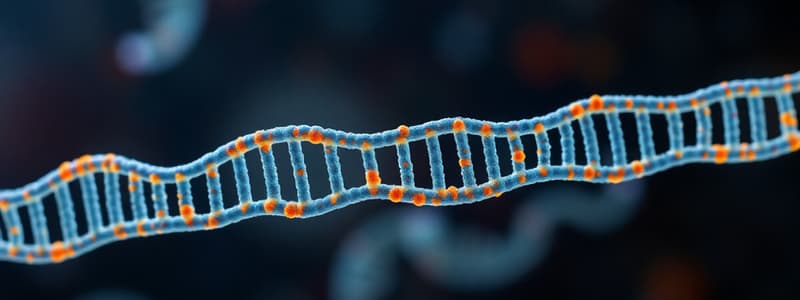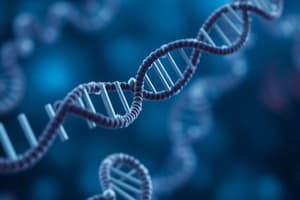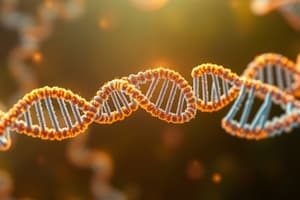Podcast
Questions and Answers
Which RNA Polymerase is responsible for transcribing mRNA and microRNA?
Which RNA Polymerase is responsible for transcribing mRNA and microRNA?
- RNA Pol III
- RNA Pol II (correct)
- RNA Pol IV
- RNA Pol I
What is the primary function of the TATA Binding Protein (TBP)?
What is the primary function of the TATA Binding Protein (TBP)?
- To bind the TATA box and recruit transcription factors (correct)
- To add a methyl group to RNA
- To phosphorylate RNA Polymerase II
- To unwind DNA during transcription
Which process involves the addition of a guanosine monophosphate to the RNA strand?
Which process involves the addition of a guanosine monophosphate to the RNA strand?
- Promoter Recognition
- Splicing
- 5’ Capping (correct)
- Polyadenylation
Which factor plays a role in both helicase and kinase activities during transcription initiation?
Which factor plays a role in both helicase and kinase activities during transcription initiation?
What role do Poly-A binding proteins serve during RNA processing?
What role do Poly-A binding proteins serve during RNA processing?
During transcription elongation, what is the importance of CTD phosphorylation?
During transcription elongation, what is the importance of CTD phosphorylation?
What does the Cleavage and Polyadenylation Specificity Factor bind to during RNA processing?
What does the Cleavage and Polyadenylation Specificity Factor bind to during RNA processing?
Which RNA Polymerase is involved in ribosome synthesis by transcribing rRNA genes?
Which RNA Polymerase is involved in ribosome synthesis by transcribing rRNA genes?
What role does telomerase play in the elongation process of telomeres?
What role does telomerase play in the elongation process of telomeres?
Which process occurs in eukaryotic cells but not in prokaryotic cells?
Which process occurs in eukaryotic cells but not in prokaryotic cells?
Which type of RNA is involved in regulating mRNA stability and translation?
Which type of RNA is involved in regulating mRNA stability and translation?
What feature distinguishes RNA from DNA regarding its stability?
What feature distinguishes RNA from DNA regarding its stability?
What is the function of telomere binding proteins like TRF1 and TRF2?
What is the function of telomere binding proteins like TRF1 and TRF2?
Which of the following is true about the 3' overhang of telomeres?
Which of the following is true about the 3' overhang of telomeres?
What process is described by the elongation phase in the context of telomere maintenance?
What process is described by the elongation phase in the context of telomere maintenance?
What does the start codon AUG signify in the context of protein synthesis?
What does the start codon AUG signify in the context of protein synthesis?
Which type of RNA is most abundant and plays a structural role in ribosomes?
Which type of RNA is most abundant and plays a structural role in ribosomes?
What is the primary role of the 5' splice donor sequence in intron splicing?
What is the primary role of the 5' splice donor sequence in intron splicing?
Which component is responsible for phosphorylating RNA polymerase II during the initiation stage of transcription?
Which component is responsible for phosphorylating RNA polymerase II during the initiation stage of transcription?
What role does the guanosine cofactor play in the self-splicing of introns?
What role does the guanosine cofactor play in the self-splicing of introns?
In what stage of transcription does the RNA polymerase II pause to enable a quick stress response?
In what stage of transcription does the RNA polymerase II pause to enable a quick stress response?
Which type of alternative splicing is most commonly observed?
Which type of alternative splicing is most commonly observed?
How does miRNA function differently from siRNA in gene regulation?
How does miRNA function differently from siRNA in gene regulation?
What is the outcome of the second step in the two-step transesterification splicing mechanism?
What is the outcome of the second step in the two-step transesterification splicing mechanism?
Which element facilitates the processing of RNA through co-transcriptional modifications?
Which element facilitates the processing of RNA through co-transcriptional modifications?
What is the primary mechanism by which Dicer processes hairpin RNA into miRNA?
What is the primary mechanism by which Dicer processes hairpin RNA into miRNA?
How do introns contribute to gene regulation?
How do introns contribute to gene regulation?
Which enzyme's primary function is to remove the poly-A tail from mRNA during decay?
Which enzyme's primary function is to remove the poly-A tail from mRNA during decay?
What is the first step in the siRNA pathway after Dicer processes dsRNA?
What is the first step in the siRNA pathway after Dicer processes dsRNA?
Which exonuclease is involved in the torpedo model of transcription termination?
Which exonuclease is involved in the torpedo model of transcription termination?
Which of the following is NOT a component of the spliceosome assembly?
Which of the following is NOT a component of the spliceosome assembly?
Which mechanism interferes with translation initiation by blocking ribosome assembly at the 5' end?
Which mechanism interferes with translation initiation by blocking ribosome assembly at the 5' end?
Which of the following distinguishing features characterizes siRNA in relation to miRNA?
Which of the following distinguishing features characterizes siRNA in relation to miRNA?
What is the role of Inosine in the wobble hypothesis?
What is the role of Inosine in the wobble hypothesis?
Which of the following statements is true concerning prokaryotic ribosomes?
Which of the following statements is true concerning prokaryotic ribosomes?
During the initiation of translation in eukaryotes, what is the function of the Cap Binding Complex?
During the initiation of translation in eukaryotes, what is the function of the Cap Binding Complex?
In prokaryotic translation, what is the purpose of the Shine-Dalgarno sequence?
In prokaryotic translation, what is the purpose of the Shine-Dalgarno sequence?
Which ribosomal site is primarily responsible for holding the growing polypeptide chain during translation?
Which ribosomal site is primarily responsible for holding the growing polypeptide chain during translation?
What catalytic activity does the peptidyl transferase perform?
What catalytic activity does the peptidyl transferase perform?
Which RNA polymerase is responsible for synthesizing 5S rRNA?
Which RNA polymerase is responsible for synthesizing 5S rRNA?
What happens to deacylated tRNA after it leaves the P site?
What happens to deacylated tRNA after it leaves the P site?
What is the first step in producing cDNA from eukaryotic mRNA?
What is the first step in producing cDNA from eukaryotic mRNA?
Which enzyme is used to create sticky ends by digesting the cDNA?
Which enzyme is used to create sticky ends by digesting the cDNA?
During the process of producing recombinant DNA, what method is used for delivering Fosmids into bacterial cells?
During the process of producing recombinant DNA, what method is used for delivering Fosmids into bacterial cells?
Which technique is specifically used to confirm the presence of a DNA insert in a plasmid?
Which technique is specifically used to confirm the presence of a DNA insert in a plasmid?
What role does T5 exonuclease play in the Gibson Assembly method?
What role does T5 exonuclease play in the Gibson Assembly method?
What is a characteristic feature of dideoxynucleotide triphosphates (ddNTPs)?
What is a characteristic feature of dideoxynucleotide triphosphates (ddNTPs)?
What is the purpose of the His-tag in protein purification?
What is the purpose of the His-tag in protein purification?
Which method allows the cloning of multiple DNA fragments in one reaction without using restriction enzymes?
Which method allows the cloning of multiple DNA fragments in one reaction without using restriction enzymes?
Flashcards
RNA Polymerase I
RNA Polymerase I
A protein complex responsible for synthesizing ribosomal RNA (rRNA) genes, excluding the 5S rRNA gene.
RNA Polymerase II
RNA Polymerase II
A protein complex that transcribes messenger RNA (mRNA), long non-coding RNA, microRNA, and some small nuclear RNA (snRNA).
RNA Polymerase III
RNA Polymerase III
A protein complex that transcribes small RNA genes, including transfer RNA (tRNA) and ribosomal RNA (5S rRNA).
TATA Box
TATA Box
Signup and view all the flashcards
TATA Binding Protein (TBP)
TATA Binding Protein (TBP)
Signup and view all the flashcards
Pre-Initiation Complex (PIC)
Pre-Initiation Complex (PIC)
Signup and view all the flashcards
TFIIH
TFIIH
Signup and view all the flashcards
5' Capping
5' Capping
Signup and view all the flashcards
DNA Replication
DNA Replication
Signup and view all the flashcards
Origins of Replication
Origins of Replication
Signup and view all the flashcards
S Phase
S Phase
Signup and view all the flashcards
Telomeres
Telomeres
Signup and view all the flashcards
Telomerase
Telomerase
Signup and view all the flashcards
T-loop
T-loop
Signup and view all the flashcards
Telomere Binding Proteins (TRF1 and TRF2)
Telomere Binding Proteins (TRF1 and TRF2)
Signup and view all the flashcards
Telomere Elongation
Telomere Elongation
Signup and view all the flashcards
RNA Synthesis and translation in eukaryotes
RNA Synthesis and translation in eukaryotes
Signup and view all the flashcards
RNA processing in eukaryotes
RNA processing in eukaryotes
Signup and view all the flashcards
Transcription Initiation
Transcription Initiation
Signup and view all the flashcards
Transcription Elongation
Transcription Elongation
Signup and view all the flashcards
Transcription Pausing
Transcription Pausing
Signup and view all the flashcards
RNA Processing
RNA Processing
Signup and view all the flashcards
Transcription Termination
Transcription Termination
Signup and view all the flashcards
Introns
Introns
Signup and view all the flashcards
Exons
Exons
Signup and view all the flashcards
Spliceosome
Spliceosome
Signup and view all the flashcards
Wobble Hypothesis
Wobble Hypothesis
Signup and view all the flashcards
Wobble Position
Wobble Position
Signup and view all the flashcards
Inosine Pairing
Inosine Pairing
Signup and view all the flashcards
Ribosome Small Subunit
Ribosome Small Subunit
Signup and view all the flashcards
Ribosome Large Subunit
Ribosome Large Subunit
Signup and view all the flashcards
A Site
A Site
Signup and view all the flashcards
P Site
P Site
Signup and view all the flashcards
E Site
E Site
Signup and view all the flashcards
Self-Splicing Intron
Self-Splicing Intron
Signup and view all the flashcards
Alternative Splicing
Alternative Splicing
Signup and view all the flashcards
Guanosine Cofactor
Guanosine Cofactor
Signup and view all the flashcards
Deadenylase
Deadenylase
Signup and view all the flashcards
Decapping Enzyme
Decapping Enzyme
Signup and view all the flashcards
miRNA (microRNA)
miRNA (microRNA)
Signup and view all the flashcards
siRNA (small interfering RNA)
siRNA (small interfering RNA)
Signup and view all the flashcards
RISC (RNA-induced silencing complex)
RISC (RNA-induced silencing complex)
Signup and view all the flashcards
cDNA synthesis
cDNA synthesis
Signup and view all the flashcards
Restriction Enzyme Cloning
Restriction Enzyme Cloning
Signup and view all the flashcards
Gibson Assembly
Gibson Assembly
Signup and view all the flashcards
Sanger Sequencing
Sanger Sequencing
Signup and view all the flashcards
Transduction
Transduction
Signup and view all the flashcards
BAC (Bacterial Artificial Chromosome)
BAC (Bacterial Artificial Chromosome)
Signup and view all the flashcards
Southern Blot
Southern Blot
Signup and view all the flashcards
Restriction Enzyme Digestion
Restriction Enzyme Digestion
Signup and view all the flashcards
Study Notes
Key Experiments Leading to DNA as Genetic Material
- Frederick Griffith (1928): Transformation in Streptococcus pneumoniae bacteria
- Avery, MacLeod, and McCarty (1944): DNA was the transforming agent
- Hershey and Chase (1952): DNA entered E. coli cells; 32P labels DNA, 35S labels protein
Experimental Evidence for Semiconservative Replication
- Meselson and Stahl (1958) used cesium chloride centrifugation and different nitrogen isotopes (N15 and N14) to label DNA
- First generation: Intermediate density (one heavy strand, one light strand)
- Second generation: A mix of light and intermediate density
Semiconservative DNA Replication - Arthur Kornberg
- Kornberg used the wrong polymerase (DNA pol I), which was too slow and short.
- DNA Polymerases in E. coli:
- DNA polymerase I (Pol I): Major repair enzyme, 3' to 5' and 5' to 3' exonucleases
- DNA polymerase II (Pol II): Replication restarts after damage
- DNA polymerase III (Pol III): Main replication enzyme, synthesizes long DNA strands, 3' to 5' exonuclease activity
- DNA polymerase IV and V: Error-prone repair mechanisms
Replicating the Bacterial Chromosome
- John Cairns used 3H-thymidine incorporation to study DNA synthesis
- One round of replication: chromosome is a double-stranded circular DNA molecule
- Second round of replication: DNA polymerase synthesizes DNA in two directions simultaneously
Steps in DNA Replication (Lagging Strand)
- Primase synthesizes RNA primer (5' to 3')
- DNA polymerase III elongates leading strand continuously
- DNA synthesized in Okazaki fragments, starting with RNA primers
- DNA polymerase I cleaves RNA primers, fills gaps and synthesizes DNA (5' to 3')
- DNA ligase seals gaps between Okazaki fragments
Replication Bubble in Prokaryotes (E. coli)
- OriC: Origin of replication in E. coli (circular genome)
- Replication in both directions from origin, forming two replication forks
- Primosome: primase and helicase
- Replisome: Multi-protein complex that carries out DNA synthesis
DNA Replication in Eukaryotes
- Multiple Origins of Replication
- S Phase
- DNA wrapped around histones and needs to be unwound
- Telomerase
- Telomeres: protective repeated DNA sequences at ends of chromosomes
- RNA of telomerase: template for extending 3' overhang of telomeres
- T-loop: 3' overhang of telomeres, stabilizing chromosomes
Studying That Suits You
Use AI to generate personalized quizzes and flashcards to suit your learning preferences.




